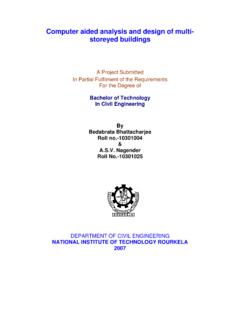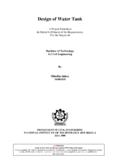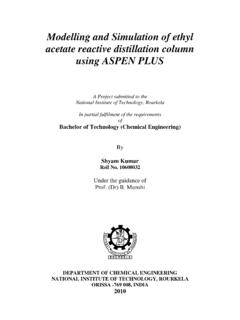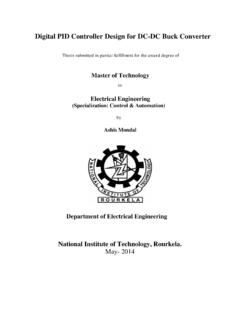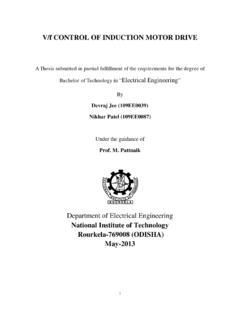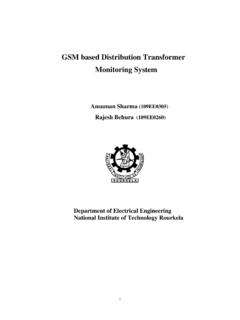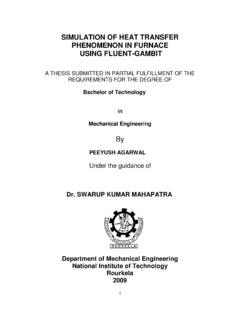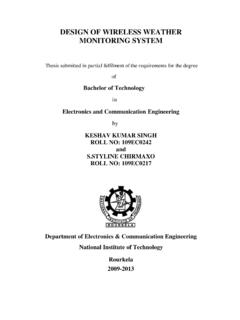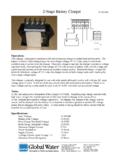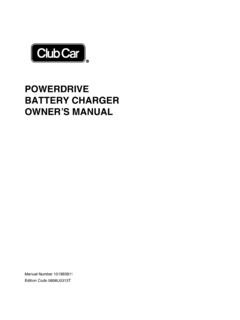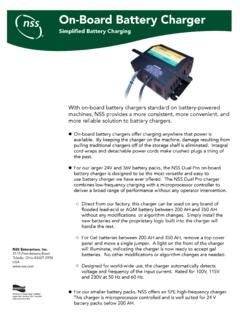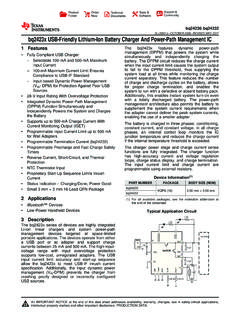Transcription of Design of a Lead Acid Battery Charger System
1 Design of a Lead acid Battery Charger System A THESIS SUBMITTED IN PARTIAL FULFILLMENT. OF THE REQUIREMENTS FOR THE DEGREE OF. Bachelor of technology In Electronics and Instrumentation Engineering By ABHIK DATTA. 10507026. Department of Electronics and Communication Engineering National Institute of Technology Rourkela 2009. National Institute of Technology Rourkela CERTIFICATE. This is to certify that the thesis entitled, Design of a Lead acid Battery Charger System . submitted by Sri Abhik Datta in partial fulfillment of the requirements for the award of Bachelor of Technology Degree in Electronics & Instrumentation Engineering at the National Institute of Technology, Rourkela (Deemed University) is an authentic work carried out by him under my supervision and guidance.
2 To the best of my knowledge, the matter embodied in the thesis has not been submitted to any other University / Institute for the award of any Degree or Diploma. Date: Prof. Dr. Dept. of Electronics and Communication Engineering National Institute of Technology Rourkela 769008. ACKNOWLEDGEMENT. I would like to articulate my profound gratitude and indebtedness to my project guide Mahapatra who has always been a constant motivation and guiding factor throughout the project time in and out as well. It has been a great pleasure for me to get a opportunity to work under him and complete the project successfully.
3 An assemblage of this nature could never have been attempted without reference to and inspiration from the works of others whose details are mentioned in reference section. I. acknowledge my indebtedness to all of them. Last but not the least to all of my friends who were patiently extended all sorts of help for accomplishing this undertaking. Date Abhik Datta CONTENTS. ABSTRACT 05. CHAPTER 1:Introduction ..06. CHAPTER 2:Charging process of batteries ..10. CHAPTER 3:Hardware Design and Simulation .. 16. CHAPTER 4:Result and Conclusion 34.
4 REFERENCES. ABSTRACT. With the lack of centralized power grids, lead acid batteries have taken the place of one of the main energy sources available in developing countries. With this in mind, our objective was to Design a cheap, versatile and efficient lead acid car Battery Charger which will interest and appeal to the cost-minded customer. Lead- acid batteries are finding considerable use as both primary and backup power sources. For complete Battery utilization, the Charger circuit must charge the Battery to full capacity, while minimizing over-charging for extended Battery life.
5 In our circuit we have used a voltage regulator and comparator to regulate the voltage supply to the Battery for effective charging. Four LED's are used to indicate the status of Battery charge. This circuit was simulates using a simulation software called Multisim, a product of National Instruments. CHAPTER 1. INTRODUCTION. INTRODUCTION. A Battery Charger is a device used to put energy into a cell or (rechargeable). Battery by forcing an electric current through it. Lead- acid Battery chargers typically have two tasks to accomplish.
6 The first is to restore capacity, often as quickly as practical. The second is to maintain capacity by compensating for self discharge. In both instances optimum operation requires accurate sensing of Battery voltage. When a typical lead- acid cell is charged, lead sulphate is converted to lead on the Battery 's negative plate and lead dioxide on the positive plate. Over-charge reactions begin when the majority of lead sulphate has been converted, typically resulting in the generation of hydrogen and oxygen gas. At moderate charge rates, most of the hydrogen and oxygen will recombine in sealed batteries.
7 In unsealed batteries however, dehydration will occur. The onset of over-charge can be detected by monitoring Battery voltage. The figure on the next page shows Battery voltage verses percent of previous discharge capacity returned at various charge rates. Over charge reactions are indicated by the sharp rise in cell voltage. The point at which over-charge reactions begin is dependent on charge rate, and as charge rate is increased, the percentage of returned capacity at the onset of over-charge diminishes. For over- charge to coincide with 100% return of capacity, the charge rate must typically be less than C/100 (1/100 amps of its amp- hour capacity).
8 At high charge rates, controlled over-charging is typically as quickly as possible. To maintain capacity on a fully charged Battery , a constant voltage is applied. The voltage must be high enough to compensate for self discharge, yet not too high as to cause excessive over-charging. Figure:- Over-charge reactions begin earlier (indicated by the sharp rise in cell voltage) when charge rate is increased. CHAPTER 2. CHARGING PROCESS OF BATTERIES. CHARGING PROCESS OF BATTERIES. Charging a lead acid Battery is a matter of replenishing the depleted supply of energy that the Battery had lost during use.
9 This replenishing process can be accomplished with several different Charger implementations: constant voltage Charger , constant current Charger or a "multistage" constant voltage/current Charger . Each of these approaches has its advantages and disadvantages that need to be compared and weighed to see which one would be the most practical and realistic to fit with our requirements. Constant Voltage Charger :- Constant voltage charging is one of the most common charging methods for lead acid batteries. The idea behind this approach is to keep a constant voltage across the terminals of the Battery at all times.
10 Initially, a large current will be drawn from the voltage source, but as the Battery charges and increases its internal voltage, the current will slowly fold and decays exponentially. When the Battery is brought up to a potential full charge, which is usually considered around , the charging voltage is dropped down to a lower value that will provide a trickle charge to maintain the Battery as long as it is plugged into the Charger . The best characteristic of this method is that it provides a way to return a large bulk of the charge into the Battery very fast.
